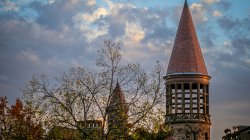The roots of the College and its mission can be traced back to 1868 when the German Theological Seminary of Newark, New Jersey first opened as a training school for German-speaking ministers in response to the influx of nearly two million German immigrants following the European Revolution of 1848.
The institution’s first four students met on September 16, 1869 in a room in the First German Presbyterian Church. Courses in theological instruction, Biblical history, pastoral work, natural philosophy, and United States history were taught in both English and German by the four full-time faculty. Classes were also conducted in Hebrew, Latin and Greek. On February 2, 1871, the school’s first Charter was approved, and on June 7, 1871, the first Constitution was approved.
On September 11, 1872, the first classes were held in Bloomfield after the school relocated to the home of the former Bloomfield Academy at Franklin and Liberty Streets, Bloomfield. The structure was renamed Seibert Hall at this time to honor the school’s first president, Rev. George Seibert. The building served as a dormitory, classrooms, faculty housing and library. In 1909, the New Jersey Legislature authorized the school to grant the Bachelor of Arts degree in addition to a Bachelor of Divinity.
As the German immigrants assimilated into American society, the need for a special theological school diminished and the Seminary soon opened its doors to students from other countries. In 1913, the school was renamed Bloomfield Theological Seminary, and was serving students from some 15 different language groups. In 1914, Knox Hall was dedicated and a “Day of Nations” was celebrated in five languages, indicative of the rich cultural diversity that characterized the student body.
Over the years, as the local population reflected greater diversity, students came to the college not only to study theology, but to gain a solid liberal arts foundation. In post-World War I years, the College received approval for a four-year program and the school’s name was again changed to Bloomfield College and Seminary.
During the 1930s, many clubs and organizations were formed adding to an engaging campus life. A new Gymnasium was designed in 1953, and a new library building was dedicated in 1955.
The College came under the sponsorship of the United Presbyterian Church in 1958 through the New Jersey Synod, now the Synod of the Northeast. In recent decades Bloomfield is no longer directly connected with the Presbyterian church, but continues as an active member of the Association of Presbyterian Colleges and Universities (APCU).
The College’s first accreditation by the Middle States Association was approved in 1960, and in 1961, the school simply became known as Bloomfield College.
To meet a growing demand, the first student residence was constructed in 1961, and in 1966, Bloomfield College added more facilities with the purchase of Westminster Church and Jarvie Hall. In 2000, the College opened a new library. The newly constructed Franklin Street Residence Hall welcomed its first students in the fall of 2014, to be followed in 2016 by Park Place as the College’s 14th on-campus residence. In 2016, the new Center for Technology + Creativity also opened offering students the use of cutting-edge computer and electronic technology.
Today, the College is designated as New Jersey’s only four-year Predominantly Black Institution (PBI), Hispanic Serving Institution (HSI) and Minority Serving Institution (MSI); and has been consistently recognized for advancing the social mobility of its diverse student population by helping students from low-income backgrounds enter the middle and upper class.
In July, 2023, Bloomfield College became a part of Montclair State University in a historic merger between a public and a private institution in the state of New Jersey, and was renamed Bloomfield College of Montclair State University.
The College offers more than 40 academic programs, Division II athletics, an active Greek life, and diverse co-curricular clubs and organizations. Its nearly 1,000 students benefit from a personalized small campus experience tailored to individual student needs with attention from faculty who care, in combination with the benefits and resources of a large doctoral research university.
